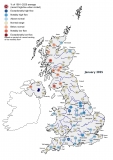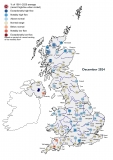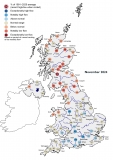Catchment Area
The surface catchment area, projected onto a horizontal plane, draining to the gauging station in square kilometres. Most (>99%) of the quoted areas have been derived using the Centre for Ecology & Hydrology’s Integrated Hydrological Digital Terrain Model (IHDTM) but in cases where the IHDTM is beleived to be inaccuarate, areas were derived from a variety of sources and are not of uniform precision.
Delineation of catchment boundaries can be especially difficult in areas of very subdued relief. In such circumstances information on drainage directions supplied by the measuring agencies may be used to determine catchment boundaries. Errors in the assessment of the areas of small catchments in particular can substantially affect runoff values. There are a significant number of gauging stations where, because of geological considerations, or as a result of water transfers (for instance, the use of catchwaters to increase reservoir yield), the actual contributing area may differ appreciably from that defined by the topographical boundary. In consequence, the river flows, whether augmented or diminished, may cause the runoff values to appear anomalous.
Catchment Boundary
Catchment boundaries are available for most of the National River Flow Archive gauging stations. These have been derived using the Centre for Ecology & Hydrology’s Integrated Hydrological Digital Terrain Model (IHDTM)REF, which has a 50m grid resolution. Difficulties surrounding the delineation of catchment boundaries are outlined above.
The outlet points used to define the catchments do not correspond precisely with the locations of the NRFA Gauging Stations as given by their Grid Reference. The outlet points were ‘snapped’ to the IHDTM grid to allow the catchment boundary to be defined. On the whole this ‘snapping’ process is automated, which can lead to errors. However a number of tests are applied, including manual inspection alongside maps in complex cases, to ensure the best IHDTM location has been identified and that the digital catchment boundary is representative of the area contributing surface runoff to the gauging station. Situations when the catchment derived from the IHDTM can be significantly different from the ‘true’ catchment include:
Complex hydrological characteristics of individual catchments which may be accounted for in the NRFA catchment area figure but are not reflected in the IHDTM generated catchment boundary (e.g. interactions between rivers and man-made features such as canals and leats at the catchment outlet; urban areas where the topographic boundary is unlikely to determine surface runoff);
Incorrect catchment boundary derived due to subdued relief;
Very small channels near the catchment outlet that were not represented in the derivation of the 50m IHDTM (i.e. that are not defined, or not correctly defined, within the OS 1:50,000 maps). Occasionally small errors have been found in the IHDTM where the flow direction or connectivity of (usually very small) streams has been wrongly defined. Where this has created a significant problem for a gauging station catchment the catchment has been manually digitised.Changes in the precise location of the gauging station between the derivation of catchment area via different methods.
When using small catchments (e.g. <100km2), users should be aware that a small absolute difference in catchment area can cause large percentage differences in calculations involving the area.
The National River Flow Archive released a major revision of catchment boundaries in 2017 and we update the catchment boundaries when new stations are added or when more accurate station locations become available. Initially only FEH Catchment Descriptors have been updated for these new catchments. Other catchment statistics will be updated in due course, but users should be aware there may be slight inconsistencies between the catchment boundary and the catchment statistics until this update has been completed.
Catchment boundaries can be downloaded in ESRI shapefile format from the spatial data page of each gauging station. Gauging station pages can be accessed through the Search pages here.
LICENCE FOR ACCESS TO CATCHMENT BOUNDARY DATA SUPPLIED BY THE NATIONAL RIVER FLOW ARCHIVE (NRFA) FROM THE CENTRE FOR ECOLOGY & HYDROLOGY (CEH)
REF Morris, D.G. and Flavin, R.W. 1990. A Digital Terrain Model for Hydrology. Proc 4th Int. Symposium on Spatial Data Handling. Zurich, 1, 250-262.



